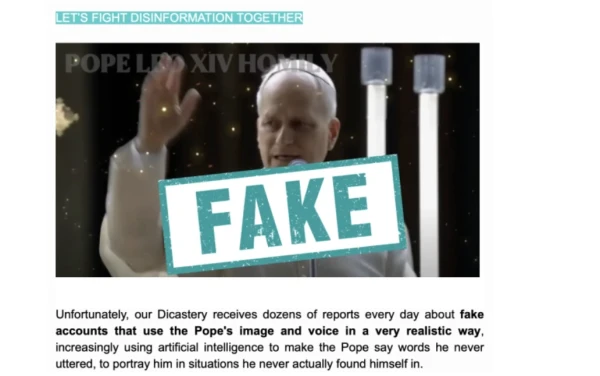Did you hear what Pope Leo XIV said about Charlie Kirk or American President Donald Trump? Have you heard what he thinks about “the rapture” or whether it is okay to be cremated?
These are some of the topics that the Pontiff has addressed extensively in videos that appear daily on social networks. The problem is that these videos are not real and the Vatican is fighting to combat their spread.
Receive the main news from ACI Prensa by WhatsApp and Telegram
It is increasingly difficult to see Catholic news on social media. Subscribe to our free channels today:
The Vatican communications team claimed to have reported hundreds of accounts, mainly on YouTube, posting fake videos of Pope Leo, created by artificial intelligence — known as “deepfakes”—, since the beginning of his pontificate. However, it has been an uphill battle, as new accounts, videos and images appear daily and emerge as quickly as the others are deleted.
“We are witnessing the exponential proliferation of a series of YouTube channels with fake videos, all similar to each other, some with the voice of Leo
A search on YouTube for the words “Pope Leo” turned up dozens of fake videos of the Holy Father purportedly making statements ranging from the plausible, such as reflections on the Eucharist, to the improbable, such as announcing his resignation.
Most of the videos have not received more than a few hundred views, however, some deepfakes They have gone viral. A now-deleted 25-minute video claiming that the Pope had broken his silence on the murder of Charlie Kirk garnered more than 445,000 views in the first seven days of its release.
one of the first fake videos that went viral after the Holy Father’s election showed him reading a statement denouncing colonialism and praising the interim president of Burkina Faso, Captain Ibrahim Traoré, a military leader who came to power through a coup in 2022. CNA and Vatican News published fact-checking articles to warn readers about false information. The 36-minute video received at least a million views before YouTube terminated the account that posted it.

“Deepfake”
The term deepfakecoined less than a decade ago, refers to videos, photos, or audio recordings altered to show people doing or saying things they have never said or done.
Pope Leo XIV, of course, is not the first Pontiff whose image has been altered. In 2015, American television presenter Ellen Degeneres shared a video in his program where Pope Francis quickly pulls out a white tablecloth from under the candles of an altar. In another image, which went viral in 2023, Pope Francis is seen with a long white padded coat.
As technology rapidly advances and produces increasingly realistic images, viewers’ innocence can be forgiven for confusing fiction with reality.
Pope Leo XIV himself recently pointed out an example of such confusion. In an interview with journalist Elise Ann Allen, he recalled his surprise when an acquaintance worriedly asked him if he was okay. In June, AI-generated photos of the Holy Father apparently falling down a staircase in front of St. Peter’s Basilica circulated online. The images, which caught the attention of Snopes fact-checking websitewere “so good that they thought it was me,” the Pope said.
The Vatican communications team warned about the proliferation of deepfakes in your monthly newsletter by email in August, and invited readers to report suspicious posts and videos to the dicastery.
“Unfortunately, our dicastery receives dozens of reports every day about fake accounts that use the image and voice of the Pope in a very realistic way, increasingly using artificial intelligence to make the Pope say words that he never uttered, to portray him in situations in which he never really found himself,” the bulletin said.
“Much of our time is spent reporting, silencing, and requesting the removal of these accounts,” the message continued. “Given the large amount of false material, it is impossible to publicly refute each and every one of them.”
The statement the dicastery sent to CNA indicated that the Vatican is not only reporting fake accounts to its platforms, but is also working to “raise awareness among our audience about this new phenomenon. We believe it is essential to invest in media literacy.”
The Vatican also reminded readers to rely on official sources, such as the Vatican’s own websites, to verify quotes: “If it’s not there, it’s most likely false.”
Translated and adapted by the ACI Prensa team. Originally published in CNA.

